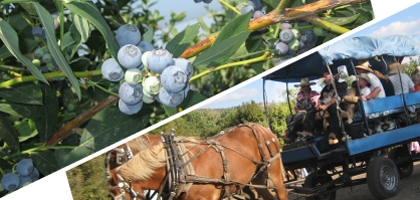This article by Matt Kettman was published in the Santa Barbara Independent on October 6, 2015. UC Small Farm Advisor, Mark Gaskell, has been providing technical assistance to small-scale growers in Santa Barbara and San Luis Obispo counties for more than 20 years. Sandra Newman has established certified organic blueberries, gooseberries, mulberries, and other specialty crops on her 100 acres of sandy soil and been growing and marketing them successfully for more than a dozen years.
Blueberries, Pinot Noir, Mulberries, and More Thrive at Sandra Newman's Forbidden Fruit Farms Near Lompoc
Story by Matt Kettmann
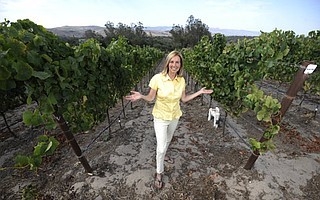
The advisor, however, asked whether she had money and time to burn. As a widow approaching retirement age, lacking a fortune, and still paying bills through her Orange County–based digital SEC filing service, Newman had neither luxury. “I have a budget,” Newman told me during a visit this past summer to the property. “My daddy didn't buy it for me; my husband didn't buy it for me. I'm probably the only one out here who still has a mortgage.”
So the advisor suggested planting blueberries, which, if they ripened anytime other than when the blueberry market is typically flooded, would deliver nearly instant returns. In went two acres of the shrubs — they ripened exactly at the right times — and Forbidden Fruit Orchards was born. Newman was soon selling her organically grown blueberries to upscale grocers and through farmers' markets from San Francisco to Los Angeles, using the proceeds to grow her property from a few abandoned apple trees into a dynamic estate with multiple buildings.
And she kept planting, from more blueberries (now 8.5 acres) to Pakistani mulberries, avocados, apples, red and pink currants, figs, bananas, gooseberries, and more. Among the more interesting choices are the hardy kiwis (smaller than usual and hairless so that you eat the whole thing, but she's still getting them to flower at the right time), green tea (an experimental project in conjunction with the University of California), and hops for beer, which are tended to by Brian DeBolt and Casey Birthisel of Pacific Valley Hops. Many of these items will be integrated into the menu of the upcoming farm-to-table, four-course dinner at the property on November 7, when Chef Sally Ruhl will unveil many of the ingredients she's posting to Twitter under her handle @SallyRuhl.
With the blueberry cash flow, Newman finally did plant wine grapes in 2007, today amounting to 7.5 combined acres of pinot noir and chardonnay. Some grapes are sold to other vintners, but she makes about 600 or so cases in her souped-up garage under the brand Cebada, named after the canyon. The wines are very light and elegant in a deliberately Old World style; the chard is tight and racy, the pinot requires a bit of bottle age to truly shine (so 2011 is great now), and the 2014 rosé is one of the best pinks I've tried of the vintage. Plenty of others think so, too, as it's rare for me to hear so many wine lovers I know rave about the same brand without any prompting.
You can taste them with an appointment at the farm, or just head to Isabella Gourmet Foods on Figueroa Street in downtown Santa Barbara, where Cebada wines are poured upstairs and Newman's jams, teas, and other products are also sold. To get the most bang out of your $10, try them during Thursday and Friday's Classy Hour, when sips come with small food pairings from 4-6 p.m.
Newman also makes a blueberry wine, further evidence that those tiny berries remain the core strength of Forbidden Fruit Orchards. She's currently tending to bidding wars over the recent harvest, since her bushes reach their prime when the market is most desperate. “We hit a really nice window,” she said, “because Chile is not in and the northern hemisphere is done.”
It's certainly not a stress-free existence, and with so many fruits in the air, Newman admits that “sometimes you just have crazy days.” But she's happy with her 100 acres of sand and the evolving cornucopia of trees, vines, and shrubs. “I just love farming,” said Newman. “I love being able to grow and pick the fruit. It's just a passion.”
- Author: Brenda Dawson
Before you can plant vegetables for a field experiment, you will need ... a field to plant them in. Sure, you'll also need a seed or a plant, some tools, some knowledge and a variety of other things.
But definitely before you can plant anything, you need somewhere to plant it. Sometimes the "where" of planting is in a pot, in a greenhouse or in a garden.
Many farm advisors — including some who work with the UC Small Farm Program — are able to plant experimental field plots at one of the nine "Research and Extension Centers" that are operated by the University of California. (Remember this video with colorful carrots and giant radishes? It was filmed at the UC Kearney Agricultural Research and Extension Center.)
But other farm advisors don't have access to a field station, so they work with local farmers who agree to allow the farm advisor to use part of their fields to test plants.
For our part of the Great Veggie Adventure, farm advisors with the Small Farm Program are planting vegetables in five counties in different parts of California — some at a Research and Extension Center, and others at cooperating farms.
In Santa Barbara County, Mark Gaskell has worked with a cooperating farm called Growing Grounds. Growing Grounds farm in Santa Maria is a non-profit farm and wholesale nursery that provides horticultural therapy and job training to mental health patients.
Recently I had the chance to visit Mark and get a tour of Growing Grounds from Ariella Gottschalk, the farm's program manager.
Mark and Ariella showed me rows of vegetables and flowers, a brightly painted farm stand and even some chickens. Then they picked some of the vegetables that were almost ready for harvest, to see how well the plants were growing.
When I visited, the farm had different rows of colorful carrots that had been planted during different months. Many of the carrots in the field were still too young and too small for harvest — some were smaller than my pinky finger!
I also had the chance to talk with Mark about some of the basic science behind field experiments like this one. One of the questions I asked Mark was: Why do we need to keep planting those vegetables over and over again, and in five different locations around the state? Play the video above to hear what Mark had to say.
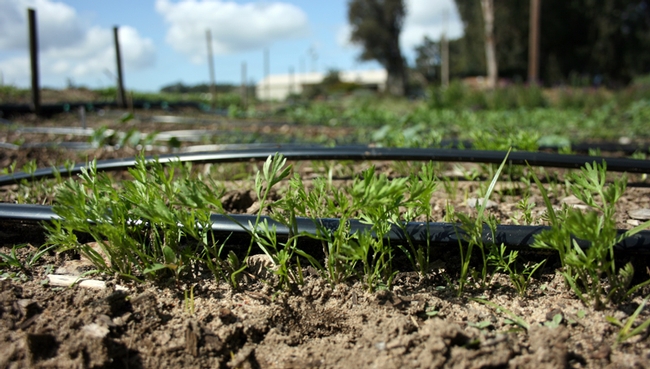
University of California Research and Extension Centers
... or have a question? Ask away.
- Author: Brenda Dawson
May 18 may be just another day, but it will be a busy one for the UC Small Farm Program.
That's because on May 18, the Small Farm Program will be in two places at once — hosting two educational meetings in two different locations in the state.
Before I go any further, here are the details in case you are interested in attending either one:
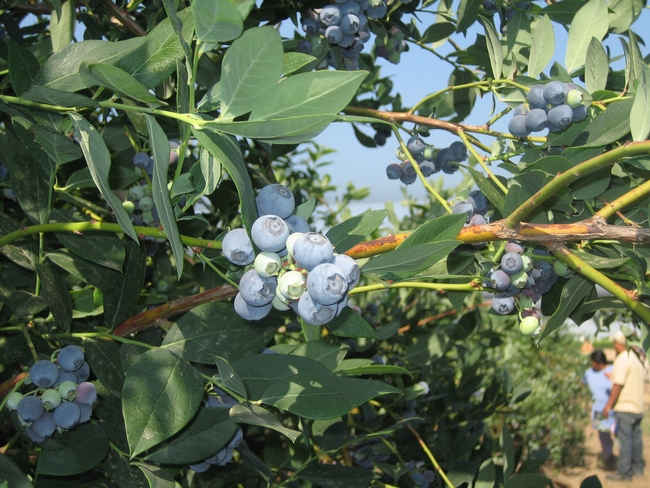
- Blackberry and blueberry field tour
9 a.m. – 3 p.m., Parlier
Visit grower fields and packinghouses, with discussions about field establishment, acidification, irrigation, harvest practices, postharvest handling practices and pruning. (The tour will be followed by a blueberry field day on May 19.) - "Growing Agritourism" workshop
8:30 a.m. – 4:15 p.m., Salinas
Meet with other agritourism operators, tourism experts and government officials to discuss marketing and planning topics. (This is the fifth offering of this workshop, which has already been offered in four other California regions this year.)
(See other small farm-related events on the Small Farm Program calendar.)
At both events, participants will be sharing research, swapping experience and networking, networking, networking.
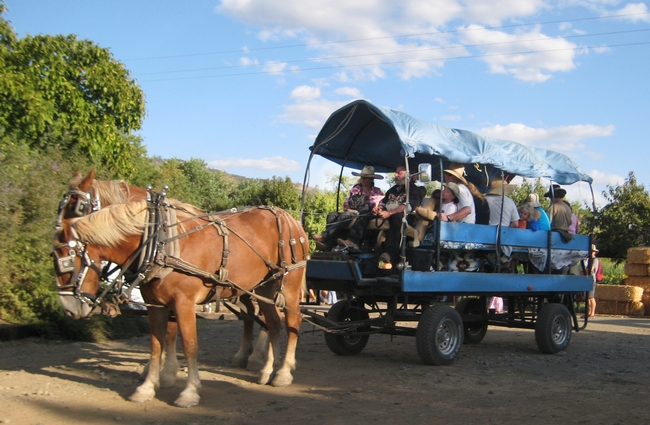
This is a good reminder that many small-scale farmers have to be skilled at both production (growing food) and marketing (selling food), as they are unlikely to have many employees.
When it comes to production, small-scale farmers can differentiate themselves by growing niche specialty crops — like blueberries. In fact, UC Cooperative Extension farm advisors with the Small Farm Program (most notably Manuel Jimenez and Mark Gaskell) have been instrumental in introducing blueberries to California farmers as a niche crop. (Here's more information about growing blueberries.)
In marketing, small-scale farmers can often get a leg up on the competition by connecting directly with consumers — and agritourism is one way to do so. The Small Farm Program has been a leader in California agritourism for more than a decade, with a statewide directory of farms to visit (CalAgTour.org) and education about agritourism for farmers (currently managed by Penny Leff).
Juggling both production and marketing can be a challenge for any farmer — just like being in two places at once.
